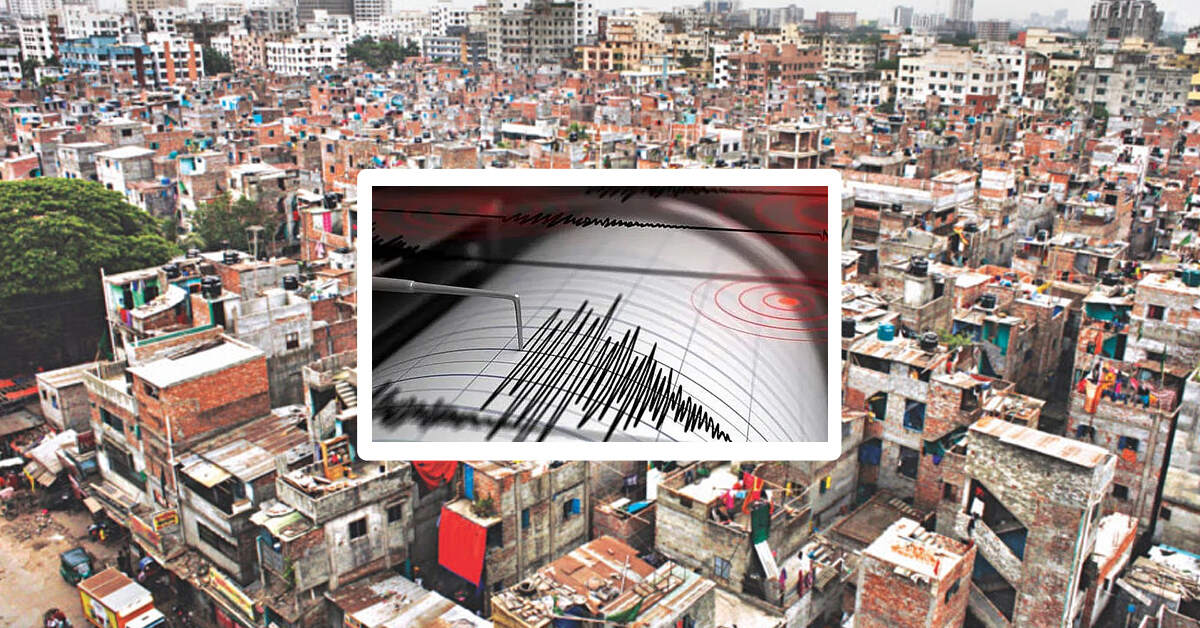Eye News Desk
Earthquake: Bangladesh witnesses highest magnitude tremor in 20yr

The earthquake that struck Dhaka last Monday measured 5.5 on the Richter scale, making it the most powerful among earthquakes originating within the country over the last 20 years.
No casualties have been reported from the earthquake yet. However, the residents of the city were in panic as the tremor lasted for a prolonged period.
The earthquake experts say the earthquake originated from a fault line known as the Dauki fault. Several earthquakes originated from this fault line in the past few years, which points to a risk of high magnitude earthquakes.
The earthquake on Monday was felt at 8:49 pm. The United States Geological Survey (USGS) has reported that its epicenter was Kanaighat in Sylhet, situated 228 km from Dhaka, near the Indian Assam border. The depth of the quake was 10 kilometres. The tremors of the earthquake were felt strongly across the country, including capital Dhaka.
Umme Salma, a resident of Shewrapara in the capital, said, she felt the tremor for almost more than a minute. Panicked by the tremor, she left the building with her children.
She said, “I have never seen a building shaking like that in an earthquake.”
When the magnitude of an earthquake crosses 5, it is called a moderate earthquake. Any earthquake below that magnitude is considered mild tremors.
According to the USGS, an earthquake on 26 July, 2003 had the highest magnitude among the earthquakes that originated in Bangladesh in recent times. It was felt in Chattogram and Khagrachhari. The magnitude was 5.6 on the Richter scale.
Bangladesh has experienced three earthquakes of more than magnitude 5. One of those was the quake felt on Monday. The other two earthquakes occurred on 15 August, 2022 and 23 January and had magnitudes of 5.1 and 5.2 on the Richter scale respectively.
In all, a total of 17 earthquakes were felt in Bangladesh in the past one year. Magnitudes of most of these earthquakes were between 4 and 5. Some 10 of these earthquakes' epicenters were in Chattogram and Cox’s Bazar area.
Speaking Rubayet Karim, an official of the Earthquake Observation and Research Centre under the Bangladesh Meteorological Department (BMD), “Usually the magnitude of the earthquakes originating within the country remains between 4 and 5. Apart from creating panic and a little tremor, it doesn’t cause much damage.”
“We haven’t seen any earthquake of magnitude 5.5 in the last 20 years. The source of the earthquake felt on Monday lies along the Dauki fault. Earthquakes are being more frequent there, which indicates to a high magnitude earthquakes in the area,” he added.
The earthquake experts say the Dauki fault between Bangladesh’s Sylhet and Assam in India extends for about 300 kilometres East-West. In 1897, an earthquake of magnitude 8.7 was recorded on the ‘Dauki fault’.
A joint research of Bangladesh University of Engineering and Technology (BUET) and the Department of History of the Dhaka University (DU) shows that the epicentre of the earthquakes occurred in 1897 was 250 kilometres away from Dhaka. There were only 100 pucca buildings and 90,000 residents in Dhaka at the time. A total of 10 buildings, including the Ahsan Manjil, were damaged in the earthquake.
Apart from the Dauki fault, another fault in Chattogram and Cox’s Bazar area is also active. There are a total of 13 faults in Bangladesh.
Usually, the tremors are strong when the depth of an earthquake is five to 15 kilometres deep underground. These sorts of earthquakes cause more damage to concrete infrastructure. The soil of a vast area of land from Dhaka to Sylhet is soft. Therefore, the amount of damage remains low even in case of a high magnitude earthquake in this region.
However, DU geology department professor Md Anwar Hossain Bhuiyan has pointed to a different type of danger. Speaking, he said, “The soil of Bangladesh is soft. At one end, it will save us from massive damage. However, if the frequency of earthquakes in an area of soft soil is high, it can cause serious damage by creating a longer tremor.”
Anwar Hossain Bhuiyan further said, “In such a situation, the soil in the hilly area gets loose, which causes landslides during the monsoon.”
According to the data of the earthquake observation centre of the geology department of DU, there were a total of 52 mild, moderate and severe earthquakes inside Bangladesh and within 200 kilometres of its territory in the last 485 years. Some six of them were felt in Dhaka and adjacent areas. Dhaka and its adjacent areas recorded a total of eight earthquakes in the past 12 years. The epicentre of these earthquakes were in Narayanganj, Mymensingh, Manikganj, Narsingdi and Dohar. The epicentres of previous earthquakes were located mostly in the Sylhet and Chattogram areas.
According to the Disaster Management Directorate, the three districts of the Chattogram hill tracts and Jaintapur in Sylhet are at the highest risk of a severe earthquake.
There is another fault in the Madhupur area in Tangail. It is known as the Madhupur fault. A 6.9 magnitude earthquake on this fault line will collapse approximately 865,000 buildings in Dhaka, according to a survey conducted by the Rajdhani Unnayan Kartripakkha (RAJUK). The survey was conducted between 2018 and 2022 under the ‘Urban Resilience Project’. It says that if such a high magnitude quake happens during the day, some 210,000 people will die.
Earthquake expert and Bangladesh Open University vice-chancellor, “The buildings in the capital and Chattogram should be made earthquake-resistant and measures to increase awareness should be taken.”
Read More
- A fire broke out in Bongo Bazar
- Takrim again first in the International Quran Competition
- Bangladesh Chhatra League full committee announced
- Today is the birthday of the father of the nation
- Enayetullah Abbasi may be banned in UK!
- Sheikh Hasina will be elected for the fourth term : Bloomberg
- Fire in Bongo Bazar: Mamun lost everything
- I will help victims of Bongo Bazar : Prime Minister
- UK PM sees Sheikh Hasina as his inspiration
- Fire in Bongo Bazar : DSCC forms probe committee






























